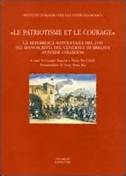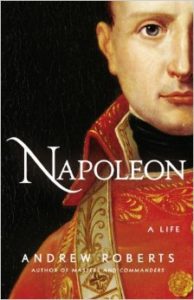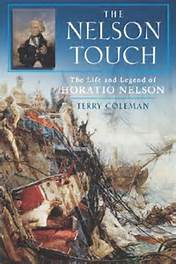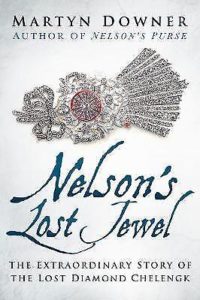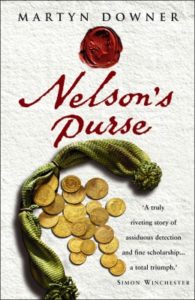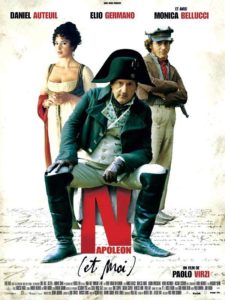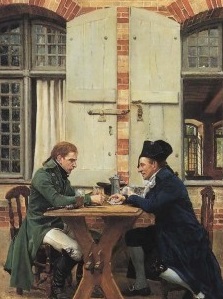 I will be adding some reviews of Napoleonic-related books, films and websites in the near future. There are so many out there, and more are constantly being added, that my reviews will, inevitably, have to be quite selective.
I will be adding some reviews of Napoleonic-related books, films and websites in the near future. There are so many out there, and more are constantly being added, that my reviews will, inevitably, have to be quite selective.
My favourite Napoleonic films are still The Duellists and the Russian version of War and Peace (the less said about the recent BBC adaptation – “shall we have a dance and wear pretty dresses, and just hope nobody is going to invade?” – the better), which made a great impression on me when it was shown on British TV. Claiming to have a favourite book on the Napoleonic era is much more difficult. If pushed I’d say the memoirs of Sergeant Bourgogne and Christopher Hibbert’s The Days of the French Revolution.
As I say, it is all very personal. And I doubt I’m consistent.
I recently did a review for the nice people at Shepherd on Lady Hamilton.
Oh, and my favourite Napoleonic work of art? That’s easy.
Books
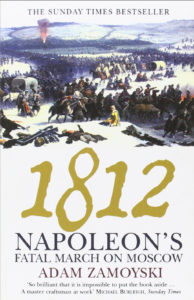 1812: Napoleon’s Fatal March on Moscow
1812: Napoleon’s Fatal March on Moscow
By Adam Zamoyski
(Harper Collins, 2005)
It was indeed a fatal march. Zamoyski does an admirable job of distilling the experienc eof a million soldiers into a single-volume history of the war. It is mostly presented from the French point of view (with accounts by assorted Poles and Germans), an understandable trait as most of the surviving accounts have come down to us from Napoleon’s, rather than Kutuzov’s, troops.
Zamoyski’s sympathy, however, does seem to be reserved for the invaders, there’s comparatively little on the suffering they wrought on the hundreds of thousands of poor peasants subjected to that invasion (and, it has to be said, Russian countermeasures). That’s possibly understandable too, as this is a military history and the peasants have left little written records of their ordeal, but, still, it would have been nice to see the innocent given some attention from western historians.
The author sketches the build-up to the war, the deterioration of relations between Napoleon and the Ruzzian czar, and the sense that Napoleon could brook no rival (it would be interesting to explore what might have happened had France and Russia maintained their peace and carried out a plan to divide the Balkans between them). Then we get the massive mobilisation which placed half a million men from across Europe on Russia’s frontier. The scorching summer advance, and the breakdown of supplies and scourge of disease, followed by a respite in the ruins of Smolensk. Then there’s more of the relentless advance and the bloody scenes at Borodino. Little credit is given to the Russian side for a nearly faultless retreat in good order, but Napoleon, who had been sketchy about what he intended to do in Russia after the long-desired major battle on the frontier failed to materialise, is, deservedly, blamed for his lack of concern for his massive army.
These events are described through the eyes of participants, some of them well-known to students and scholars, some of them newly translated. The fall of Moscow and the fateful retreat are also described by eyewitnesses. And here the book comes into its own. Freed from having to look at strategy and politics, it can concentrate on the suffering of Napoleon’s diminishing army, pursued by cossacks and by famine, brutalised by want and weakened by hunger. A terrifying ordeal over hundreds of miles of corpse-strewn roads. It makes for pitiful reading, a really brutal testament to the follies of war.
Zamoyski pities the retreating troops but possibly also echoes their prejudices. There was cruelty and barbarism, of course, from the Russian pursuers, but also many instances of kindness and care. The Russian troops were themselves hungry by the time the armies reached Lithuania, but many Russian officers and doctors attempted to feed and care for the thousands of French and allied troops they captured. Most died from disease and the consequences of want rather than deliberate Russian attempts to kill them off, and many coul dnot withstand the march away from the theatre of war (those that did fared relatively well once out of the snow). And the author certainly prefers to credit the weather with Napoleon’s defeat, only praising a Russian if he can’t really avoid it. This is a shame. Keeping Napoleon in Moscow and prodding him until he evacuated the city, and then keeping him on the same road he advanced along, were key factors in Napoleon’s defeat and Russian generals deserve some credit for this.
All in all, a very good book. It suffers from some slight bias, but it is an excellent volume and the best account of the retreat from Moscow we’ve seen for along time. Just a little publisher’s anecdote – the first print run had Mosow rather than Moscow on the title page!
Napoleon’s Paris: A Guide to the Napoleonic Sites of the Consulate and First French Empire
By David Buttery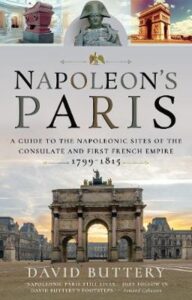
(Pen and Sword, 2020)
Napoleon transformed Paris, making it a worthy city to act as capital for his vast empire. Once he had seized control of France, and even more once he had crowned himself emperor, he would spend vast amounts of time and money reshaping it, overhauling it and adding to it, all so that Paris could serve as a statement and a symbol of France’s glory, French achievement and his power. His obsession with the French capital meant that a great deal of his legacy would live on through the embellishments and improvements he made. Of course, France would repay him by building monuments to his glory, erecting statues to his soldiers and naming streets and squares across the city after those who had formed his entourage.
Napoleon had first visited the city when the city was far from rebellion, cruising into town on a barge on 19 October 1784 and dining at the Coq Hardi. He would be back in 1787 and, when Paris was not quite looking her best, in the summer of 1792, and, on 10 August, the young Corsican witnessed the sack of the Tuileries Palace.
The Revolution would run its course in the capital, but the fate of France, and much of Europe, would continue to be decided there. For, as political upheaval relented and, over the years, the revolution stagnated, Napoleon, catapulted to power, became head of government and tied Paris to his destiny. With his star in the ascendant, he began to work on his capital and lavish it with his almost obsessive attention. That care would continue until the end of June 1815 when he was forced to flee Paris before the encroaching Prussians.
Napoleon did much in the 15 years he won for himself and David Buttery’s exemplary book guides us through the city’s lurch from capital of revolution to centre of a European empire. There is much to learn here on the city’s museums, monuments and design, and lots of fascinating detail on how Napoleon set about his self-appointed task as chief architect. Paris benefitted enormously, becoming a financial, cultural and political centre the likes of which the world had barely seen. Indeed, he made Paris fall in love with itself.
Buttery charts the building of the monuments, the restoration of the palaces, the paving of the streets, and all the intricate transformations that go into giving a city a global reputation. Butt he also looks at the ways Paris commemorated her patron, the statues scattered across the city, the museums dedicated to him and his soldiers, even the cemeteries where those warriors were laid to rest. Talking of fallen warriors, Buttery is especially good at showing how Paris was affected by those final battles of Napoleon’s regime in 1814 and 1815, and at showing how Napoleon’s capital has been changed by more recent events, be it war or the grand ambition of town planners.
There is plenty of practical information in this magnificent book, so for those concerned about opening times and transport links, you can leave your Lonely Guide or Rough Planet behind. There are some lovely mapped walks here which are particularly nice and which allow the visitor to wander with intent. There are also some great asides on the imperial palaces and sites scattered just beyond the city limits. In short, it is really the only book the Napoleonic enthusiast needs when in the capital of France.
 Beloved Emma: The Life of Emma, Lady Hamilton
Beloved Emma: The Life of Emma, Lady Hamilton
By Flora Fraser
(Weidenfield, 1986)
I have great respect for Flora Fraser’s work. She has a superb grasp of the Georgian/Napoleonic period, and an eye for some of the women (famous or infamous) who added some dash to that colourful era. Her books of Queen Caroline and Pauline Bonaparte are terrific examples of biographer’s art. But her biography of Lady Hamilton is second to none, and it is the book which first got me interested in the love triangle of Lady Hamilton, Sir William Hamilton and Lord Nelson.
She provides a neat single-volume history of a complex and full life. There’s some conjecture on Emma’s origins and early life (the record is incomplete and marred by the fantasies of detractors and supporters), and on her debut in the seedy world of Georgian London. Then the biography takes off with Emma’s rise through the ranks and, given her origins, her astonishing success, most notably her marriage to Sir William in 1791.
There’s plenty on Emma’s life in Naples, entertaining Goethe and the Grand Tourists. And much on the political life at court in the southern Italian kingdom. I would have liked more on the ghastly Bourbons, but you can find more on them in other works. I would also have liked more on the events in Naples in late 1798 and in the summer of 1799. As I see it, Hamilton exerted tremendous influence on Nelson and she acted as a conduit for the queen’s instructions on how to handle the Neapolitan rebels. She used the emotional capital she had with Nelson to persuade him to act brutally against the rebels. Their punishment was very much desired by the queen, and her sentiments were shared by a loyal Emma and by an eager-to-please Nelson. Hamilton can’t be blameless for what followed (the breaking of a treaty, and the execution and punishment of hundreds of Neapolitan revolutionaries), but nor was she entirely responsible for what Nelson elected to do to please the queen. This ambiguity means that Hamilton’s role is complex, and I’m glad Fraser, although sympathetic to her subject, steers a relatively neutral course in this minefield.
Throughout the events at Naples Hamilton and Nelson were certainly in love, but it all came to a head in early 1800. After a honeymoon off Malta and Sicily the threesome (old Sir William wa sin tow) travelled to Livorno and then Ancona, taking a Russian ship to Trieste and then a coach to Vienna. They made their leisurely back to England where Nelson was treated as a hero, but Emma as an inconvenience. After Nelson’s death we get a page-by-page account of Emma’s demise, her mismanagement of funds, her p[leading to deaf ears, and her flight from creditors to Calais. It was quite a fall, and one can’t help feel sorry for the woman, whatever one’s view of her life.
Fraser’s account is the best. It is free from the moralising of late Victorian accounts, and packs a lot into its relatively modest size. I hope for an updated edition as much has come to light since publication 30 years ago.
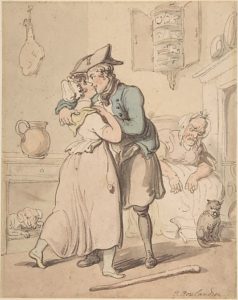 Jack Tar
Jack Tar
The Extraordinary Lives of Ordinary Seamen in Nelson’s Navy
By Roy and Lesley Adkins
Roy and Lesley Adkins have done a great service to landlubbers like me. My view of the closed and rather alien world of life on board ships in the age of sail has been a distant one, often obscured by the jargon and technical details which underpin the daily grind. But it is true to say that Jack Tar restores the all-important human dimension, by looking at the experience of life at sea, and relegating talk of mizzens and shoals to an absolute minimum. Instead, most of the book is taken up with accounts of the life and times of sailors, officers and marines during the American Revolution, and the wars following the French Revolution. The book is broken down thematically – recruitment (willing or otherwise), diet, disease, fighting, captivity, etc, and is drawn from first-hand accounts. This is the best part, judiciously selected excerpts from letters, diaries, memoirs and contemporary newspapers which provide an authentic, and detailed, record of the life and times in the Royal Navy. The extracts have been carefully selected, few are well-known or overly familiar, and they have been handled in such a way as to build a careful, thematic narrative. And, as an added bonus, a great effort has been made to select material from the writings of ordinary seamen, a difficult task given that few were great writers and the universal complaint that sailors had so little free time. Accounts by officers are used to add some more detail, and give the gentleman’s perspective on life within wooden walls, and, inevitably, to give a superior’s view of his challenging subordinates. The bibliography is good, the index admirable and the illustrations are nicely selected (more can be found on the Adkins’ own website).
I learnt a lot, but I have to thank the authors for opening up a whole new world, rich in potential reading. I’d like to learn more about the life of Captain Wybourn, whose writing seems particularly fine, and the travails of John Howe, whose life seems particularly rough. That’s the nice thing about studies relying on personal accounts – they provide an entry point into a new world, and the extracts suggest what your next steps in that world might be. The account of a surgeon in the West Indies, of an admiral off Brest, or a marine in Dalmatia? Yours for the taking. Jack Tar is a great, and entertaining, service to us all.
Edited by Georges Segarini and Maria Pia Critelli, introduced by Anna Maria Rao
(Vivarium, 2000)
This is one of the best books on what it was life to be an officer during the wars of the French Revolution and Napoleon. It is based on the correspondence and journals of Antoine Girardon. He was an interesting individual, having fought during the American War of Independence and then been an enthusiastic supporter of France’s own revolution. A decade later and he was Colonel of the 12th Line in and promoted to General of Brigade in early 1799. This astonishingly detailed book looks at his career in Italy. He served under Macdonald and Championnet under Rome and then took part in the conquest of Naples in December 1798 and January 1799. He was then given an independent command and entrusted with the fortress of Capua as the French withdrew the bulk of their forces and the armies of the reaction, led by Cardinal Ruffo, pushed back. They took Naples in June 1799 and Capua was then besieged, falling at the end of July.
The book is important because it shows how war is fought. Girardon had to suppress guerrillas around Capua and was then besieged by semi-regular troops later supported by British, Portuguese, Turkish and Russian contingents. It shows how he had to think of everything – how to collect food, gather intelligence, keep subordinates active, raise morale, control civilians, fight guerrillas and defend a fortress. His letters are frank, pithy, detailed and direct. His diary of the siege allows him to confess the difficulties he faces, draw lessons and lay out projects and thoughts.
The editors have done a superb job. The text is in Girardon’s French, and helpful explanatory footnotes and context is in Italian. The work deserves to be better known. This isn’t the glorious account of war you’ll find in Marbot, but the exhausting struggle, perhaps recognisable to most soldiers, when an officer is obliged to pit duty and responsibility against seemingly relentless brutality and confusion.
by Andrew Roberts
(Allen Lane, 2014)
It was doubly brave of Andrew Roberts to publish a flattering biography of Napoleon. For one thing, there have been quite a few before. And for another, he published it in Britain. That’s brave, because the British Isles seem to me the last bastion of the black legend, a place where the Corsican Ogre can still seem to stalk the land looking for naughty children. This attitude is just a reflection of the relentless barrage of propaganda rained down on the British by a government horrified by the French revolution, and jeopardised by Napoleonic ambition. Typified by the writings of Lewis Goldsmith, who, like Robert Conquest, went from being a believer into being the most animated critic of revolution, nothing hostile to Napoleon seemed unprintable, no slander too outrageous. It had an enormous impact and whilst other countries have lauded the military hero, or the administrative genius, Britain has seemed slow to accept too many positive traits in its old rival.
Roberts wears his colours on his sleeve, his title setting the tone. It isn’t quite a hagiography, or pure hero worship, but it does seek to reveal Napoleonic genius in its many forms. Not unsurprisingly, given Roberts’s previous book on Napoleon and Wellington, the author concentrates on the military campaigns, and revels in Napoleon’s mastery of the battlefield. He doesn’t neglect politics, he doesn’t turn his back on the consul’s or emperor’s personal life, but he does enthuse most about Napoleon conquering Europe.
The detail is excellent, the narrative moves along at a great pace. Much use is made of the new edition of Napoleon’s letters (which show him to have been even more interested in micromanaging his territories than thought possible), and of neat pen-portraits of comrades, rivals and enemies. When it comes to weaving in the enormous cast of characters involved in Napoleon’s life, and the enormous numbers of places dragged into the Napoleonic odyssey, this account proves itself to be one of the better biographies out there.
I have just two gripes. Although it is touched upon in the book, I personally think more should have been made of the human cost of war. Britain, of course, pursued a mercantile war which dismissed peace as an option, and should assume blame for stirring up war with the gold of empire. But it seems to me, too, that Napoleon was never happier than when conducting a campaign, or planning a war. Perhaps that’s the nature of empire, that they have to pre-empt conflict by subduing rivals and overawing populations. But, again, that’s not the whole story. Invading Russia, or marching into Portugal, or occupying Calabria – there was always more war, a constant ulcer bleeding the peoples of Europe dry. Was it for a good cause? Perhaps, Napoleon was certainly progressive, French rule brought tangible benefits, and order. But it also brought conscription. And not everything about French rule was so positive. For one thing I think it worth noting that things did not always go so well in those places the emperor could not be present. His family, placed on various thrones, seemed woefully undeserving of power, and few of his imperial governors were worthy of note. Whilst a constant stream of orders emanated from Paris much of the administration was inherited from earlier times, and incapable of acting, or being coerced, into action for the public good. Nor was the empire free from that other scourge of public life – corruption. Napoleon’s subordinates were especially talented when it came to extortion, and Napoleon either turned a blind eye to such abuse, or connived in it to pass it off as deserved reward for diligent service. These problems imposed considerable burdens on much of Europe.
As I said, these are gripes. I do recommend the book, and it is a great read. It should finally deal with the myth that the Corsican was an ogre.
by Terry Coleman
(Oxford, 2002)
There are so many biographies of Horatio Nelson out there, but this amongst the best. I’m a little in awe of the scholarship. Coleman must have spent years in dusty archives, methodically noting down sources and painstakingly attempting to decipher the scrawl that is Nelson’s handwriting. A quite remarkable example of scholarship and patience. Just as remarkable is the pithy writing, which sparingly concentrates a vast amount of information, and a compelling narrative, in a single volume.
It covers an adventurous period, peopled with an interesting cast. But, rightly, Coleman keeps the focus on Nelson, only detailing others when they play a major part in the formation of the hero’s character or fate. The biography is, then, wonderfully detailed. There’s the early years making a reputation in the West Indies and off Canada. There’s the desperate years of peace and boredom, and then the drama of the war against revolutionary France. Bloodshed in the Mediterranean. Glory off Egypt. Intrigue in Naples. Hard work off Copenhagen. And a hero’s death at Trafalgar.
My own interest is limited to the episode at Naples in 1798 and 1799. The evacuation of the royal family as revolution breaks out in December 1798 and then Nelson’s role as the monarchs’ avenger in June 1799. There he sailed into the harbour to find that Cardinal Ruffo, commander of the king’s land forces, had accepted the surrender of the republican garrisons and agreed to ship them to Touolon. Nelson protested, but then seemed to agree and the garrisons marched out and boarded 14 transports, all with the clear expectation that they were going into exile. But Nelson prevented them from sailing, arrested the leaders and handed them over for trial. This was a scandal, Nelson had quite clearly overturned a valid treaty of capitulation in order to allow the Bourbon’s to seize prisoners who, otherwise, would have been sent to safety and exile in Toulon. Coleman gives a lot of detail and offers a condensed version of this great drama which hold Nelson’s reputation for integrity in the balance. His conclusion is reasonably fair, but perhaps should have emphasised that, had the treaty of capitulation been found wanting, or if the argument that Ruffo had no authority to sign it been found convincing, then the laws of war dictated that the republicans waiting on their transports in the harbour should, by rights, have been placed back in their forts. Instead, Nelson handed them over to their executioners. An act of questionable politics, and dubious morality.
by Martyn Downer
The History Press 2017
Last summer, on the other side of the Atlantic, there was a wave of anger directed at statues of Confederate generals. A spate of demolition from Maryland to North Carolina saw marble memorials to yesterday’s men bite the dust, or, perhaps more accurately, saw them turned to dust. Over here, with a capital in which Cromwell stands opposite a bust of Charles Stuart (glowering over a doorway to the parish church of the House of Commons), there has been little appetite to move against the symbolism of the past in the squares of the present. Nevertheless, in August 2017, an indignant broadside by Afua Hirsch in the Guardian stated that she expected that every man and woman would do their duty by questioning the unwise commemoration of one particular British hero: Horatio Nelson. It pointed out the admiral had been an advocate of slave owners’ interests during a brief presence in parliament, and so, beneath an illustration of a Baghdad-style toppling of Nelson’s column, suggested we should cleanse our streets of memorials to this long-gone white supremacist. Before this hint could launch a fleet of revisionist bulldozers, Nelson’s admirers leapt to the admiral’s support, manoeuvring to defend a man they see as “a fundamental icon of British national identity. Inspirational leadership, duty – and humanity”.
These extremes are as useful as a debate examining whether it is an unhappy country which needs heroes or a bland land which has had to do without. Whatever one chooses or is persuaded to believe about Nelson, it is clear that a monument is merely an introduction to, and no substitute for, the whole story. A good biography serves much better, especially if it allows the subject to be seen from all sides by all sides.
Martyn Downer’s book on an exotic gift, a diamond Chelengk of 13 diamond rays, sent to Nelson in thanks for destroying Napoleon’s fleet at the battle of the Nile in 1798, is seemingly about that jewel but, seen in the context of the ongoing battles over memory, it is in fact rather more. Indeed, it is an unusual biography of the naval hero told through the story of one of his possessions. The jewel plays a central role, and its interesting fate warrants close attention, but through it we meet the real Nelson, and explore the themes of heroism and its rewards. Indeed, the legacies of great men are central to this story of Georgian fame and the double-edged nature of celebrity.
The jewel was just one reward gifted to the famous sailor but, as Downer notes, it was exotic enough to take the admiral’s fancy. During his lifetime Nelson the victorious admiral was often treated lavishly for his exertions, and loss of eye and limb. The naval hero had been knighted for Saint Vincent, and loaded with gold and the freedom of the City of London, but destroying the fleet of the hated French off Aboukir in August 1798 unleashed a wave of popular enthusiasm. The burning decks had hardly sunk to the bottom of the Mediterranean when a battered Nelson, resting in Naples among his keenest admirers, Sir William and Emma Hamilton, and King Ferdinand and Queen Maria Carolina, was swamped by a jingling cascade of gifts and rewards. The relieved Sultan Selim sent the resplendent Chelengk for Nelson’s hat, as well as a zibeline pelisse, whilst his mother added a rose set with diamonds; the snub-nosed Czar Paul sent a snuffbox, as did the king of Sardinia; Ferdinand of Naples, that sex-pest in silk, would present a more martial gift, an ornamented sword. Downer’s research into the world’s generosity is eye-opening, and underscores that in the Age of Sail, the status of hero, although transient, could bring real, tangible rewards.
As Downer also makes clear, such generosity created the risk that the British crown, and Whitehall, would fail to meet expectations now the bar had been raised so high. London did not even try to compete and was as stingy as the foreign powers had been lavish. Instead of raising him to viscount, they dubbed him a mere baron. Emma, perhaps a little too outspoken for the wife of England’s Envoy Extraordinary, lambasted the ministers, telling Nelson’s wife that Sir William “ is in a rage with the ministry for not having made Lord Nelson a viscount, for sure this great and glorious action, greater than any other, ought to have been recompensed more. Hang them I say.”
No doubt Nelson, who, after all had fought for his king and his country, and was an avowed patriot, was deeply hurt by such official parsimony. These complications in the mundane life of a great man are teased out in Nelson’s Lost Jewel and remind us that the promise of eternal fame could not readily be cashed in during one’s lifetime. Nor could Nelson satisfy his restless craving for recognition and status with diamonds, titles and medals. Gratifying, certainly, but never quite enough.
Jilted by London, Nelson settled into the Hamiltons’ villa in Naples, nourished by milk and ceaseless admiration. Emma, soon to be Nelson’s mistress, heaved and declared that for his victory he deserved a gold statue in London; Sir William flattered him too, calling him “our bosom friend” and immortal; Ferdinand, wiping his favourite mozzarella from his lips, was briefly overcome whilst the august Maria Carolina demanded a portrait of brave Nelson for her bedroom. The contrast between London’s indifference and Neapolitan warmth unfortunately tied Nelson to a kingdom just as it was on the brink of political disaster. Nelson’s actions in the troubled year to come would very much call into question his status as hero. They form a blot on his record and whilst forgotten in England, memories of the perfidious acts of Albion’s hero are kept alive in Italy. His misdeeds have nothing to do with white supremacy, a failing true of most Georgians, but rather with his cruel treatment of thousands of Italian revolutionaries.
As Downer shows Nelson’s arrival in southern Italy prompted not only gift-giving but also war. The shambolic Neapolitan state hoped to surprise a France shaken by the loss of her fleet and her Bonaparte, and Maria Carolina even talked of making her husband king of a united Italy. The bellicose queen, goaded into war by Nelson and the Hamiltons, sent her husband northwards to push the French from Rome before tragedy and farce collided and the Neapolitans, crushed by a small French army, fled back home. The royals took Nelson’s ship for Sicily and the surprised French proclaimed a liberal republic in Naples. This ephemeral republic, governed by well-meaning reformists intent on conferring liberty and equality on the carcass of the kingdom, lasted six months before Cardinal Ruffo, leading a horde of bloodthirsty pilgrims, arrived and lay siege to the capital. Trapped by a Holy Army of freebooters and cannibals, the republicans agreed to surrender Naples on condition they be allowed to leave for France. Just as they were about to do so, Nelson sailed in from Palermo to save the royal day. He lured the republicans out into the harbour on the pretext they could now depart, then tore up the act of surrender, and promptly handed thousands of unfortunates over to a merciless court. The defeated republicans, whose ministers had been doctors, lawyers, botanists, Greek translators and poets, were subjected to the full force and barbarity of royal justice in the market places of Naples in that summer of 1799.
The royal family were again grateful, making Nelson Duke of Bronte, and Emma Hamilton, basking in reflected glory, completed her journey from Duke Street to a duke’s bed. Downer again lists this more uncomfortable generosity, but notes that such a victory could win few friends. The Loyal Opposition back home was even moved to condemn this bloody series of events and naval officers turned askance at the admiral’s vindictiveness. Southey, an early biographer of the admiral, would agree for he too lambasted Nelson for the betrayal of the Neapolitan republicans, calling it “a deplorable transaction, a stain on the memory of Nelson and upon the honour of England”. Downer does not shrink from criticising Nelson for having made possible, and indeed encouraged, this royalist vendetta and, despite the subsequent Victorian smoothing of Nelson’s record, intent on purifying the empire’s anointed, it is clear that Nelson had innocent blood on his hands. Nelson apparently cared little for the stains on his fingers, for he was again the centre of attention and sat sporting his diamond decorations and philandering whilst the hangman was busy.
However, even this triumph over royal enemies, and all the expressions of royal gratitude, grew stale and, as more conscientious subordinates cast reproachful glances and irritated superiors rebuked him for ignoring their orders, the critical tide eventually carried the diamond-encrusted but heavily indebted Nelson home. From then on until his hero’s death at Trafalgar only Copenhagen saved him for a bitter decline as a second-rate backbencher and adulterer, a decline in status later lived out by poor Emma as she tried to keep creditors at bay by selling off precious keepsakes.
Trafalgar erased that fate for Nelson, and restored the admiral to his pinnacle of popularity. He was not around to enjoy it, but his pickled corpse was given a hero’s funeral, and, before long, heroic biographies paved the way for the erection of that immutable column so beloved of pigeons and Jacob Rees-Mogg. The heroic achievements lingered throughout the days of empire, whilst the snuffboxes and medals and other assorted relics, were traded, sold or placed in glass cases. The spangled Chelengk, central to Downer’s book on the trappings of heroism, went on to live a rich life of its own and end it days with a twist.
So, even in his own lifetime, Nelson lived a heroic and ordinary life. There was adulation, with crowds pulling his carriage through the streets, and there were public snubs, such as the famous one from the still-sane George III. There were acts of immortal bravery, along with episodes of unforgettable cruelty. Downer’s book, as much a biography of Nelson and his friends as a quest for a half-remembered jewel, does not turn a blind eye on Nelson’s shortcomings and reminds us that the remarkable people in history can encompass greatness and pettiness in equal measure.
Given Nelson’s very real blemishes, should we allow Nelson’s column to remain or should it meet the fate of Dublin’s Nelson’s Pillar? Afua Hirsch may not agree, but, yes, Nelson’s column should still sit in Trafalgar Square whilst it is still Trafalgar Square. There it can act as a constant reminder that heroes and history can never be black and white.
by Martyn Downer
(Bantam, 2004)
This is an unusual book. Unusual in that it presents such a wealth of information whilst seeming, on the surface, to be about the life of one man. One great man. Nelson. I don’t think I have read anything quite like it as it builds a picture of the common, everyday concerns of a hero. His finances, his correspondence, his relationships. How he managed his career, kept his partisans loyal, derided his enemies and, on the more mundane level, tried to make the best of his life. The complexities of a career in the navy, from winning patronage to dealing with the rancour surrounding the distribution of prize money, are expertly handled, but just as importantly the role of those around Nelson, those who belonged to Nelson’s circle, is nicely teased out from a mass of often contradictory material. The importance of those around Nelson has often been overlooked by biographers too intent on the hero and, despite the occasional foray into the careers of the band of brothers (the Egyptian Club), or into the mesmerizing career of Emma Hamilton, there has been little room for others in accounts of Nelson’s life. But Downer brings to the fore those intriguing characters, hitherto neglected, who play a crucial role in Nelson’s career or in the construction of the Nelson legend following his death at Trafalgar. Aside from the canting pack of Nelsonian relatives, two important personalities emerge: Nelson’s wife, Fanny, and Nelson’s agent, Alexander Davison, a man with the talent of serving as a calm anchorage in stormy weather. Each plays a central part in the story, and whilst Fanny’s presence interjects interludes of pathos between stories of battles and broadsides, the story of Davison, hounded by care, earning sympathy by attempting to steer a course of pragmatic commerce through the whirlwind of Nelson’s life, is just as engaging.
The fate of Fanny is amongst the saddest of those who revolved around Nelson, and it is amongst those often overlooked. As well as relying on previously published correspondence from Nelson’s wife, Downer puts 72 letters from Fanny to Davison to good use. This correspondence. Loaded with anxiety, contributes greatly to our understanding of how Nelson’s estranged wife viewed her husband, eyed Lady Hamilton and warily observed those around them.
Then there is Davison himself. The story on Davison because it was the discovery of Davison’s trunk, and the archive of documents which it contained, and the research on them which resulted, which formed the basis for the project. Perhaps some of the ancillary details of his biography, such as his life in Canada, could have been culled, but I suppose the author wanted Davison the man to emerge from under the label of Davison the agent. The personality which emerges from these pages makes me think that there is a Davison behind each great figure. After all Napoleon had his Berthier. They underpin a vision and send a great cause in a controlled direction. The reward was wealth in Davison’s case but both Davison and Berthier fell from grace. Davison tumbling in a confusion of debt and mortgage, Berthier falling to his death from an open window before Napoleon gambled all at Waterloo.
There is someone else lurking in Nelson’s life: Emma Hamilton. She was an obsession for Nelson, and trouble for Davison. Her presence is at first far off as she captures Nelson’s heart at Naples and Palermo. Their love, and the rise and fall of revolutions and monarchies, make for a show which might eclipse Vesuvius. But their return to England pitched Davison’s already difficult task towards impossibility, and Fanny’s sensitivity to breaking point. That life in England is perhaps underrepresented here, although Emma’s fight for a portion of Nelson’s inheritance makes for an epic tale of conflicts won and lost, but what we see here of Emma shows that she, too, Nelson’s most effervescent satellite, faded after the hero’s passing.
To reduce this book to a biography of Nelson, or those destined to play his satellites, is a disservice. And it would be just as wrong to think of it as a study of the memorabilia relating to the admiral, items which often have biographies of their own, or a study of how the life of objects contributes to the formation of legends. There is much more going on here. In a sense this is a multi-layered series of biographies which merge into one and which will inform the historian, widen the perspective of the expert and create a richer picture for those just embarking on the satisfying task of discovering the life of England’s most fascinating admiral.
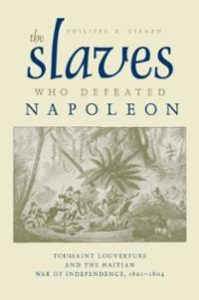 The Slaves who Defeated Napoleon
The Slaves who Defeated Napoleon
Toussaint Louverture and the Haitian War of Independence, 1801-1804
by Philippe R. Girard
(The University of Alabama Press, 2011)
On the surface the story of Napoleon’s expedition to Saint Domingue (present day Haiti) is a simple tale. A dictatorial Bonaparte, turning his back on the principles of the revolution, sends an army to return the island’s slaves to servitude, returning the colony to French control and allowing France to enjoy once again the immense profits from sugar production. This simplistic story is peopled with one-dimensional characters, who, at first glance, confirm the idea: the calculating Bonaparte; the worthy Toussaint Louverture; Napoleon’s sister, Pauline, behaving like a Roman empress; French troops, more used to fighting for liberty and equality, shocked at having to impose imperialism on heroic rebels.
But history is never quite so straightforward. Napoleon was not really aiming at restoring the old order. He had been prompted to move because the situation in Saint Domingue was spiralling out of control, threatening to wipe the French presence in the West Indies and Louisiana off the map and replace it with a fragmented series of enclaves locked into civil war. Just as importantly, it seemed as though Toussiant Louverture was plotting to place himself at the head of the colony, a clear challenge to the French ruler’s pretence to command France and her overseas possessions.
Napoleon, whilst he paid heed to the slavers and refugee colonists, determined on sending an expedition to restore order, restore French rule but not, at least not yet, restore slavery. As an indication of the importance he attached to the expedition, he placed his brother-in-law, Leclerc, in command and sent his finest fleet, carrying veteran troops, westwards. When they landed in early 1802 the traditional narrative takes over. It was blacks against whites, freedom-loving ex-slaves against those seeking to take away their liberty, hypocritical Europeans pretending they stood for liberty whilst imposing imperial rule. But, as Philippe Girard shows, that’s more a fairy tale than an historical truth. Many of the ex-slaves fought for the French. Some of the Europeans deserted to fight alongside the Haitians, especially after Toussaint Louverture had been despatched to captivity in Europe and Dessalines took over the leadership of the revolt. Many of the French were revolted by having to side with the old plantation owners. And, most surprising of all, those Haitians who led the revolt against what they perceived to be the reimposition of slavery had been slave owners themselves. This is true of Dessalines, but it is also, most surprisingly, true of Toussiant Louverture.
This is just one of the fascinating aspects of this episode. Preconceptions – a war of liberation by ex-slaves yearning for freedom from European imperialism was actually led by black officers who had themselves owned slaves during French rule. It shows just how nuanced history is, and warns us not to turn our past into a simplistic morality tale.
My own interest in the Saint Domingue expedition stems from reading some of the many French accounts of what life was like during that notoriously brutal campaign. Girard provides a brilliant and concise history of the war, and its wider implications, which sets all those accounts in context. Based on considerable archival research, it is a measured study, careful and reasonable in the moral minefield of Haitian history, and rightly makes some of the recent hyperbole about whether Napoleon waged a genocidal war in the West Indies seem lurid. He brushes aside many of the myths of the Haitian Revolution, and many of those stemming from those biases which plague Napoleonic historians. And he is particularly good at looking at the links between this localised war and its international implications, from the effect on American trade to the renewal of the war in Europe. But he doesn’t neglect the colour and the drama: the poor Poles, so recently fighting for Polish independence but who Napoleon now shipped over, to placate the Austrians, and abandoned in a war not of their own choosing; the scourge of the Yellow Fever; the brutality of Dessalines on the part of the Haitians and Rochambeau on the part of the French; the inevitable disaster, and the purging of the white colonists in 1804; and the final showdown in 1809 when the last French garrison was evicted from its walled sanctuary.
My only complaint is with the title, although I suspect the publisher’s marketing team insisted on “the slaves” who defeated Napoleon as “the former slaves” isn’t quite as punchy. That aside, the book is commended. A very welcome work on a very neglected subject.
TV and Film
(2006, French language)
Whilst it is always nice to watch Monica Bellucci, and Daniel Auteuil is one of France’s greatest living actors, this rather frothy historical comedy disappoints. It is set on Elba in 1814 where Martino, an inhabitant fond of revolution and who loathes everything Napoleon stands for, is surprised to find his nemesis taking control. Napoleon has been exiled and is establishing a miniature empire on the island. He is also looking for a librarian, and, oddly, Martino seems to fit the bill. The two warm to each other, [spoiler alert] only for Napoleon to slip away in the night. Sounds fine, doesn’t it? A clever juxstaposition in which a well-meaning liberal meets authoritarianism personified. And the acting is good, with some short moments of genuine pathos and charm.
But, on the whole, this film is all hollowed out, a wasted opportunity. The film sways towards pantomime (poor Neil Campbell is ridiculed mercilessly), any subtle consideration or sympathy for the characters, any delight in mulling over the themes of the personal melting the ideological, is drowned out by the brash direction, with the actors charging around like over-tired children. And as for Napoleon himself, well Auteuil puts in a workmanlike performance; it isn’t great, and it isn’t majestic, and it probably isn’t one he’ll remember with any sense of pride.
A frace, then. But the costumes, oh the costumes, are delightful.
When I saw that Andrew Davis was adapting Tolstoy’s monumental work on the trials and tribulations of some Russian families during the Napoleonic Wars, I was quite excited. He had a great reputation, and he had done an excellent job with Wives and Daughters. And the hype was pushing it as Great Drama, with costumes, sex and artillery. But, I’m sorry to say, this BBC adaptation of Tolstoy’s work was terrible.
The dialogue was insipid, and was never allowed to develop as we were dragged from one scene to the next in the time it takes to flutter an eyelid. We were treated to a kind of pared-down text: there were sufficient words to keep the plot moving, but insufficient to give any context, develop any ideas, or allow the characters to show any nuance or personality beyond what was needed to label them as naive, manipulative, trustworthy or sinister. With such poor scripting the cast therefore became caricatures, however much they might struggle against it or try to rebel with looks and glances and swirling capes.
This inevitably meant that the characterisation was poor. The cast looked good, considerable effort had been made in the wardrobe department, and some of the acting was excellent (thank you, Jim Broadbent). But their words and therefore their actions were all so one dimensional. Natasha was some kind of air-headed girl who liked dancing and giggling; Prince Andrei a cold nobleman with excellent hair; and Kuragin was rendered into a pantomime villain. Then there was Pierre. Pierre, so central to the story, so important a vehicle for the great themes of fate and destiny, reduced to the level of a confused adolescent, wandering around from salon to battlefield and heaped with the final ignominy of having his quest to find himself amidst great events reduced to an “I think I love you” moment with Natasha. He was dreadful.
I can’t fault the locations, although I am increasingly bothered by the tendency in drama to worship wealth. Rich people with rich people’s problems. There was hardly any mention of serfdom, no mention of the episode in the book of how a nobleman sells a family so he could buy a borzoi dog, no real explanation of why, in the midst of the French advance to Moscow in 1812, the serfs might be questioning the old order and thinking that now might be a good time to talk about emancipation. That undercurrent of tension, those stirrings of dissatisfaction with a corrupt system, could have been there. Instead, there were parties, smiles, picnics in the country, social order and hierarchy as it should be. The nobility, wealthy to the core, troubled by love and affairs of the heart, and the pesky French, everyone else absent.
This all built up a picture of Downton Abbey on the Dnepr rather than Napoleonic Russia. Or of a second-rate romance – for affairs of the heart seemed to trump every other feeling from the book – embelished with Pride and Prejudice’s ballrooms and Home and Away’s depth of character.
As someone interested in the period, and in Russia, I couldn’t help find fault with some of the smaller problems, too. The music. Yes, I understand a Russian Orthodox choir lends some Russianness to your film. But why use music that celebrates the birth of Christ to illustrate a battle scene? It was like having the machineguns of Gallipoli accompanied by Handel’s Messiah. The historical scenes. Well, Austerlitz was fought in the winter, so no green trees. And no Czar riding around in the aftermath of battle – the allies had been defeated and had run off. Borodino was better, but that scene where Kutuzov decides to abandon Moscow, well that took place before the battle, not, as the film would have it, afterwards. No need to play fast and loose with the history, the drama would not have lost out if you’d remained true to the book and to the events.
What’s to blame? The fact that there were just six episodes? No, I don’t think so. Ignorance about Russia? A little bit, I suspect (although Dominic Lieven’s influence on some of the more intricate details was welcome). I think it was a deliberate attempt to make the drama more accessible, essentially by making it into a different drama than the one Tolstoy envisaged and millions have enjoyed. It chose to make it into a romance, something a bit lighter and fluffier than the battle between fate and history Tolstoy was aiming at. It wanted to be something where there was love and loss, and pretty dresses! And dancing! And uniforms! Really, there’s plenty of lightweight stuff that can be adapted, or try Georgette Heyer if you want to try to make a film from good Regency Romance. But if you are going to adapt Tolstoy, please make it serious and weighty. You might say “but all that stuff about how history crushes our plans and hopes is rather heavy”. But that’s what you get with Tolstoy. If you want inanity, stick to Julian Fellowes.
